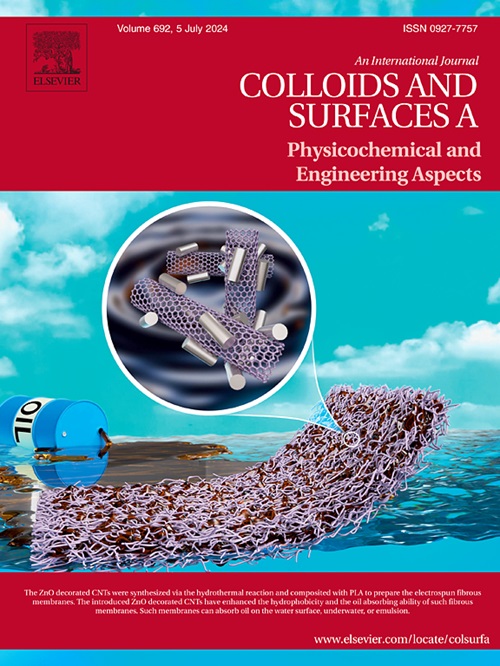GeS monolayer as an emerging 2D semiconductor for heterojunction solar cells: A first principles and device-level study
IF 5.4
2区 化学
Q2 CHEMISTRY, PHYSICAL
Colloids and Surfaces A: Physicochemical and Engineering Aspects
Pub Date : 2025-07-24
DOI:10.1016/j.colsurfa.2025.137839
引用次数: 0
Abstract
Two dimensional materials have emerged as a promising new class of photovoltaic materials due to their unique optoelectronic properties and tunable structures, offering new strategies to improve solar cell performance. Here, we employed periodic density functional theory (DFT) and SCAPS 1D simulations to investigate the photovoltaic potential of GeS. At the HSE06 level of theory, the unstrained GeS monolayer exhibits a Eg of 2.36 eV. Optical characterization confirmed the material’s intrinsic anisotropy, while strain-induced structural changes and enthalpy variations were also quantified. In the a-lattice direction, tensile strain increased the band gap from 2.42 to 2.60 eV, whereas compressive strain from −1 % to −5 % reduced it from 2.25 to 2.00 eV. Similar trends were observed in the b and ab directions. SCAPS 1D simulations reveal a power conversion efficiency (PCE) of 6.70 %, demonstrating the feasibility of GeS for photovoltaic applications. Additionally, impedance spectroscopy analysis was further used to investigate the charge transfer dynamics and resistive behavior in heterojunction solar cells with varying GeS layer thicknesses. These findings underscore the potential of GeS as a promising 2D semiconductor for the next generation solar cells and provide a comprehensive theoretical and computational framework for optimizing its integration into silicon-based heterojunction devices.
异质结太阳能电池中新兴的二维半导体:第一性原理和器件级研究
二维材料由于其独特的光电特性和可调结构,为提高太阳能电池性能提供了新的策略,成为一种有前途的新型光伏材料。在这里,我们采用周期密度泛函理论(DFT)和SCAPS一维模拟来研究GeS的光伏势。在理论的HSE06水平上,未应变的GeS单层的Eg为2.36 eV。光学表征证实了材料的本征各向异性,同时还量化了应变引起的结构变化和焓变。在a晶格方向上,拉伸应变使带隙从2.42增加到2.60 eV,而压缩应变从- 1 %到- 5 %使带隙从2.25减小到2.00 eV。在b和ab方向上也观察到类似的趋势。SCAPS 1D模拟显示,其功率转换效率(PCE)为6.70 %,证明了GeS用于光伏应用的可行性。此外,阻抗谱分析进一步研究了不同锗层厚度的异质结太阳能电池的电荷传递动力学和电阻行为。这些发现强调了GeS作为下一代太阳能电池有前途的2D半导体的潜力,并为优化其集成到硅基异质结器件中提供了全面的理论和计算框架。
本文章由计算机程序翻译,如有差异,请以英文原文为准。
求助全文
约1分钟内获得全文
求助全文
来源期刊
CiteScore
8.70
自引率
9.60%
发文量
2421
审稿时长
56 days
期刊介绍:
Colloids and Surfaces A: Physicochemical and Engineering Aspects is an international journal devoted to the science underlying applications of colloids and interfacial phenomena.
The journal aims at publishing high quality research papers featuring new materials or new insights into the role of colloid and interface science in (for example) food, energy, minerals processing, pharmaceuticals or the environment.

 求助内容:
求助内容: 应助结果提醒方式:
应助结果提醒方式:


